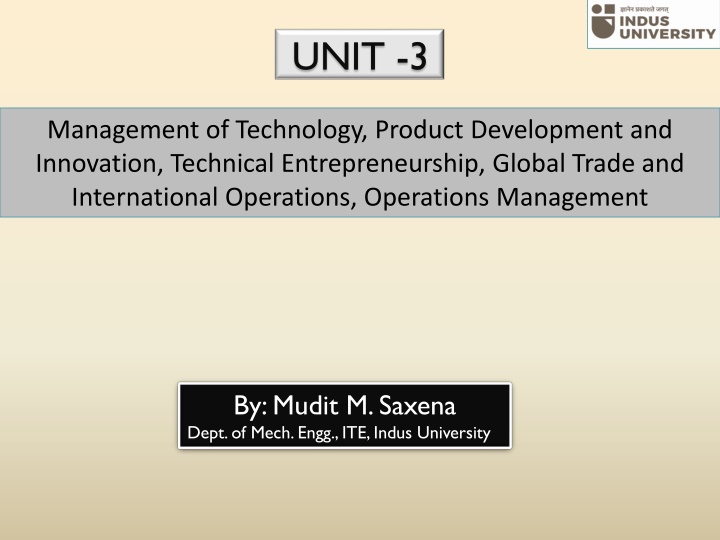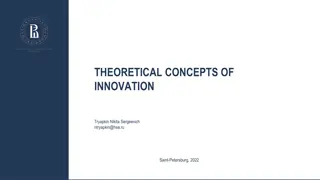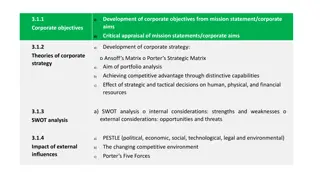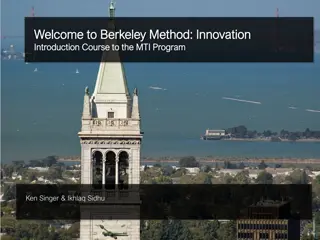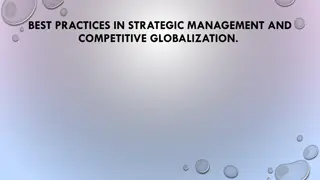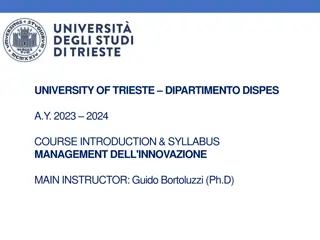Technology Management and Innovation: Strategic Planning for Competitive Advantage
Technology Management focuses on developing, implementing, and assessing capabilities to meet strategic objectives, integrating planning and design to optimize technological products and services for competitive advantage at national and enterprise levels. The field includes technology strategy, forecasting, road-mapping, and portfolio management to drive sustainable economic growth through innovative technologies.
Download Presentation

Please find below an Image/Link to download the presentation.
The content on the website is provided AS IS for your information and personal use only. It may not be sold, licensed, or shared on other websites without obtaining consent from the author.If you encounter any issues during the download, it is possible that the publisher has removed the file from their server.
You are allowed to download the files provided on this website for personal or commercial use, subject to the condition that they are used lawfully. All files are the property of their respective owners.
The content on the website is provided AS IS for your information and personal use only. It may not be sold, licensed, or shared on other websites without obtaining consent from the author.
E N D
Presentation Transcript
UNIT -3 Management of Technology, Product Development and Innovation, Technical Entrepreneurship, Global Trade and International Operations, Operations Management By: Mudit M. Saxena Dept. of Mech. Engg., ITE, Indus University
Technology Management Technology Management (MOT) is concerned with development, planning, implementation & assessment capabilities to shape and accomplish the strategic & operational objectives of an organization or central planning goals and priorities of a nation. of technological Technology Management can also be defined as the integrated planning, design, optimization, technological products, processes and services, a better definition would be the management of the use of technology for human advantage. operation and control of Technology Management is set of management disciplines that allows organizations to manage its technological fundamentals to create competitive advantage.
Technology Management The Association of Technology, Management, and Applied Engineering defines Technology Management supervision of personnel across the technical spectrum and a wide variety of complex technological systems. as the field concerned with the Technology Management programs typically include instruction in production and operations management, project management, computer applications, quality control, safety and health issues, statistics, and general management principles. Typical concepts used in technology management are technology strategy ,technology forecasting , technology road-mapping (mapping technologies to business and market needs), technology project portfolio ( a set of projects under development) and technology portfolio (a set of technologies in use).
Technology Management Technology Management (MOT) is mainly carried out at two levels: At National Level At Enterprise Level Technology Management (MOT) At National Level main obejective of is to assure that the nation and its business firms gain sustainable technological compeitiveness in the international markets and maintain strong position in the international business on long-term basis.
Technology Management a. At national level, the domain of technology management includes the followingareas: Developing approprate technology strategy for the nation (e.g. internalisation vs externalisation strategy of the nation) Technology forecasting (i.e. forecasting the technological changes) Justification / appropriateness of new technology (including justification for technology adoption ) Sustainable technologies; renewable energy technologies Sustainable economic growth Planning national technology portfolio developmentof
TechnologyManagement a. Contd Knowledge mangement (i.e. creation, deployment and protection of national technological knowledge base) Managing external technology guidelines for foreign technology collaborations Managing technology absorption Managingtechnology diffusion Performance measurement of new technology Technology and environment accounting, Environment Protection Act, 1986 etc) Technolgy and health & societal management acquisitions viz management (Green
Technology Management Technology Management (MOT) At Enterprise Level main obejective is to assure that the firm gains & maintains a srong position in its core technologies which are relevant to its product-market relationship and that these technologies support the firm s competitive strategies.
Technology Management b. Overview of Technology Management (MOT) At Enterprise Level
Technology Management b. Evolution of Technology Management (MOT) At Enterprise Level
Technology Management At enterprise level, MOT includes followingareas: Developing technology strategy (e.g. leader versus follower strategy) Technology forecasting Managing enterprise s technology portfoio Technovation (technology innovation) Knowledge management (e.g. creation, deployment, transfer and protection of firm specific technological knowledge viz through patent etc) Implementation of new technology (including its integration with the existing structure, systems and workforce)
Technology Management b. Contd Technology transfer (inculding problems & management issues), Technology absorption (inculding problems & management issues) Managing technology change (including organizational issues viz productivity and quality of work life) Integration of engineering (R&D) and new project) leading to successful implementation / commercialization Integration of product and process technology ( for delivering the objects) management (of
Technology Management c. contd Technology advancement (e.g. learning and process improvement) Managing technology at the boundary / border of the firm (e.g. collaboration and coordination with supply chain partners and customers) and Technology diffusion (from firm to suppliers and customers) Performance measurement of new technology (e.g. technlogy assessment, technology audit and feedback) Technology and environmental sustainability (e.g. environmental impact assessment,environmental audit, discharge of environmental responsibility, green marketing etc)
The Key Tasks ofMOT The key tasks of MOT at enterprise level may be summed up as below: Technology Planning like deciding technology strategy, selecting appropriate technologies etc. R&D Management Innovation Management Strategic Management of Technology (SMOT)
Strategic Management of Technology ( SMOT) Strategic Management of Technology (SMOT) means that the product, service or process technologies of an organization / enterprise are managed from a long range prespective, as these technologies have wide-ranging effects on all levels and functions in the organization.
STRATEGIC TECHNOLOGY MANAGEMENT SYSTEM(STMS) Strategic Technology Management System (STMS) calls for adopting systems approach in the organization on long term basis i.e. STMS emphasizes systematic management of technology on long term basis as the technology moves along its life cycle from birth to decline.
STRATEGIC TECHNOLOGY MANAGEMENT SYSTEM (STMS) Strategic Technology Management System isa systems life cycle approach for strategic management of technology that includes eight phases as shown below:
Phases of STRATEGIC TECHNOLOGY MANAGEMENT SYSTEM (STMS) I. Technology Creation This phase involves creation & generation of new technologies. This phase involves following activities: Creativity & Invention Innovation Senior management commitment to technology creation and generation Developing requisite & supportive corporate culture for promoting technology creation and generation
Phases of STRATEGIC TECHNOLOGY MANAGEMENT SYSTEM (STMS) II.Technology Monitoring This phase calls for monitoring technology trends and changes before implementing new technology. It involves following activities : Installing & developing information systems for monitoring technological trends and changes Competitive analysis to understand competitiveness provided by existing and prospective technologies Customer & supplier interfaces to understand market and technological changes People links (viz. internal staff, research bodies etc) to understand market trends and technological changes
Phases of STRATEGIC TECHNOLOGY MANAGEMENT SYSTEM (STMS) III. Technology Assessment This phase involves following activities : Understanding directions of markets in terms of technology Integration of technology & business planning Customer interfaces to assess the commercial feasibilty of prospective technologies Assessing contributions of technology projects to business strategy
Phases of STRATEGIC TECHNOLOGY MANAGEMENT SYSTEM (STMS) IV. Technology Transfer This phase leads to transfer of technology from external source to own Research and Development (R&D); and internally from R&D to production. This phase involves following activities : Entering strategic alliances to develop or acquire potential technologies Using product design teams for reaping benefits of planned technological change Reducing functional barriers to technology transfer Utilizing people links for successful technology transfer i.e. involving people across the organization
Phases of STRATEGIC TECHNOLOGY MANAGEMENT SYSTEM (STMS) V. Technology Acceptance This phase calls for acceptance of technology as a beneficial change and involves following activities : Supportive organizational design & structures Supportive corporate culture Senior management commitment Asessment of impacts of technological change on orgnanization, enhancing benefits, reducing adverse effects, smoothening barriers / hurdles in the change
Phases of STRATEGIC TECHNOLOGY MANAGEMENT SYSTEM (STMS) VI. Technology Utilization This phase involves following activities : Effective project management for seeking maximum utilization Process technologies to support and facilitate maximum utilization Supportive marketing starategies, efforts and utilizing feedback for improvement This phase leads to technology growth as reflected by incease in sales.
Phases of STRATEGIC TECHNOLOGY MANAGEMENT SYSTEM (STMS) VII. Technology Maturity This phase involves analyzing maturity of existing technology and its related products / services / processes through study of followingindicators: Efficiency vs. effectiveness contributed by the current technologies in attaining organizational goals Market stability in terms of volumes / sales Rise of substitutes in the marketplace Diminished returns on investment Decline of market share Loss of competitiveness in the marketplace
Phases of STRATEGIC TECHNOLOGY MANAGEMENT SYSTEM (STMS) VIII. Technology Decline This is the last phase. During this phase a technology and its related products / services / proceses/ applications show substantial / sharp decline in usage / applications / sales. Technology and its associated products or services become ordinary commodity. Technology degrades and becomesobsolete. This phase calls for movement to new technological opportunities. Thereafter the cycle re-starts by the creation of a new technlogy / movement towards a new technology. All the above steps are repeated .
Product development Product development typically refers to all of the stages involved in bringing a product from concept or idea, through market release and beyond. In other words, product development incorporates a product s entire journey, including: Identifying a market need Conceptualizing and designing the product Building the product roadmap Developing a minimum viable product (MVP) Releasing the MVP to users Iterating based on user feedback
Product Development Process 1stStep: IDEA GENERATION To systematically search for new product ideas. The process of creating, developing, and communicating ideas which are abstract, concrete, or visual. The process includes the process of constructing through the idea, innovating the concept, developing the process, and bringing the concept to reality.
Product Development Process 2ndStep: IDEA SCREENING Good ideas are pinpointed while poor ones are dropped as soon as possible. A process used to evaluate innovative product ideas, strategies and marketing trends. Idea screening criteria are used to determine compatibility with overall business objectives and whether the idea would offer a viable return on investment. Whatever does not meet these criteria is typically discarded.
Product Development Process 3rdStep: CONCEPT DEVELOPMENT AND TESTING The surviving ideas should next be developed into product concept. Product Idea - is an idea for possible product that the company can see itself offering to the market. Product Concept is a detailed version of the idea stated in meaningful consumer terms. Product Image is the way the consumers picture an actual or potential product. Concept Testing new product are tried with the group of target consumers.
Product Development Process 4thStep: MARKETING STRATEGY DEVELOPMENT Involves designing an initial marketing Strategy for introducing the product into the market.
Product Development Process 3 Stages in Marketing Strategy Development 1st Stage: Describing the target market, the planned production, positioning, sales, market share and profit goals for the first few years. 2ndStage: Outlining the product s planned price, distribution and marketing budget. 3rd Stage: Describing the plan, the long run sales and profit.
Product Development Process 5thStep: BUSINESS ANALYSIS Involves a review of sales, cost, and profit projections to find out whether they satisfy the company s objective. 6thStep: PRODUCT DEVELOPMENT The research and development or engineering department develops the product concept into physical product. 7thStep: TEST MARKETING Stage where the product itself and marketing program are tested in more realistic and marketing setting. 8thStep: COMMERCIALIZATION Introducing and marketing the product.
Introduction Stage The period of slow sales growth as the product is being introduce in the market. Growth Stage Rapid market acceptance and increasing profit. Maturity Stage The period of slowdown in sales growth because the product has achieved acceptance by most of the potential buyers. Decline Stage The period when sales fall off quickly and profit drops.
Product Innovation The development of new products, changes in design of established products, or use of new materials or components in the manufacture of established products. 2 Category of Product Innovation Development of New Product Improvement of existing product.
Product innovation Product innovation is defined as: The development of new products, changes in design of established products, or use of new materials or components in the manufacture of established products Numerous examples of product innovation include introducing new products, enhanced quality and improving its overall performance. Product innovation, alongside cost-cutting innovation and process innovation, are three different classifications of innovation which aim to develop a company's production methods. Thus product innovation can be divided into two categories of innovation: radical innovation which aims at developing a new product, and incremental innovation which aims at improving existing products.
Advantages and disadvantages Advantages of product innovation include: Growth, expansion and gaining a competitive advantage: A business that is capable of differentiating their product from other businesses in the same industry to large extent will be able to reap profits. This can be applied to how smaller businesses can use product innovation to better differentiate their product from others. Product differentiation can be defined as "A marketing process that showcases the differences between products. Differentiation looks to make a product more attractive by contrasting its unique qualities with other competing products. Successful product differentiation creates a competitive advantage for the seller, as customers view these products as unique or superior."[4] Therefore, small businesses that are able to utilize product innovation effectively will be able to expand and grow into larger businesses, while gaining a competitive advantage over its remaining competitors. Brand switching: Businesses that once again are able to successfully utilize product innovation will thus entice customers from rival brands to buy its product instead as it becomes more attractive to the customer.One example of successful product innovation that have led to brand switching are the introduction of the iPhone to the mobile phone industry (which has caused mobile phone users to switch from Nokia, Motorola, Sony Ericsson,etc. to the Apple iPhone).
Advantages and disadvantages Disadvantages of product innovation include: Counter effect of product innovation: Not all businesses/competitors do not always create products/resources from scratch, but rather substitute different resources to create productive innovation and this could have an opposite effect of what the business/ competitor is trying to do. Thus, some of these businesses/ competitors could be driven out of the industry and will not last long enough to enhance their product during their time in the industry. High costs and high risk of failure: When a business attempts to innovate its product, it will inject lots of capital and time into it, which requires severe experimentation. Constant experimentation could result in failure for the business and will also cause the business to incur significantly higher costs. Furthermore, it could take years for a business to successfully innovate a product, thus resulting in an uncertain return. Disrupting the outside world: For product innovation to occur, the business will have to change the way it runs, and this could lead to the breaking down of relationships between the business and its customers, suppliers and business partners. In addition, changing too much of a business's product could lead to the business gaining a less reputable image due to a loss of credibility and consistency.
Technical Entrepreneurship Technology entrepreneurship is a vehicle that facilitates prosperity in individuals, firms, regions, and nations. The study of technology entrepreneurship therefore, serves an important function beyond satisfying intellectual curiosity.
Technical Entrepreneurship Technology entrepreneurship is about: i) operating small businesses owned by engineers or scientists; ii) finding problems or applications for a particular technology; iii) launching new ventures, introducing new applications, or exploiting opportunities that rely on scientific and technical knowledge; and iv) working with others to produce technology change.
Technical Entrepreneurship Definition of technology entrepreneurship is based on four elements: 1. Ultimate outcomes. Value creation and capture are identified as two outcomes of technology entrepreneurship because the sources that create value and the sources that capture value may not be the same over the long run. 2. Target of the ultimate outcomes. The firm is identified as the target organization for which value is created and captured. 3. Mechanism used to deliver the ultimate outcomes. Investment in a project is the mechanism mobilized to create and capture value. A project is a stock of resources (i.e., specialized individuals and heterogeneous assets) committed to deliver the two ultimate outcome types for a period of time. 4. Interdependence of this mechanism with scientific and technological advances. The individuals involved in a project influence and are influenced by advances in relevant scientific and technology knowledge. The project exploits or explores scientific and technology knowledge. External and internal individuals and organizations co-produce the project s outputs.
Technical Entrepreneurship Technology entrepreneurship, as defined above, applies equally well to newly formed or established firms as well as small or large firms. Established and large firms can engage in technology entrepreneurship just as well as startups do. Technology entrepreneurship is about collaborative production decisions, not about a single individual making or delegating decisions. The firm s top management team jointly decides to invest in a project and a team of specialized individuals who create and capture value for the firm. The specialized individuals and assets can be held by a single entrepreneur-manager or can be distributed. Technology entrepreneurship involves specialized human resources, tapping into their skills and ability to collaboratively explore and exploit scientific and technological change to benefit the firm. Technology entrepreneurship is best understood therefore, as a joint-production phenomenon that draws from a team of specialized individuals from multiple domains, some or all of whom become embedded in the technology path they try to shape in real time (Garud and Karn e, 2003; tinyurl.com/6pdm8bn). Technology entrepreneurship is not about a single individual or the inventions they introduce. It is about managing joint exploration and exploitation, where each individual has roles and responsibilities in collaboratively and cooperatively moving forward toward accomplishing shared goals (Lindenberg and Foss, 2011; tinyurl.com/6oh6yuo). Technology entrepreneurship is about investing in and executing the firms projects, not just recognizing technology or market opportunities.
International trade International trade is the exchange of capital, goods, and services across international borders or territories. In most countries, such trade represents a significant share of gross domestic product (GDP). While international trade has existed throughout history (for example Uttarapatha, Silk Road, Amber Road, scramble for Africa, Atlantic slave trade, salt roads), its economic, social, and political importance has been on the rise in recent centuries. Carrying out trade at an international level is a complex process when compared to domestic trade. When trade takes place between two or more nations factors like currency, government policies, economy, judicial system, laws, and markets influence trade. To smoothen and justify the process of trade between countries of different economic standing, some international economic organisations were formed, such as the World Trade Organization. These organisations work towards the facilitation and growth of international trade. Statistical services of intergovernmental and supranational organisations and national statistical agencies publish official statistics on international trade.
Characteristics of global trade A product that is transferred or sold from a party in one country to a party in another country is an export from the originating country, and an import to the country receiving that product. Imports and exports are accounted for in a country's current account in the balance of payments. Trading globally may give consumers and countries the opportunity to be exposed to new markets and products. Almost every kind of product can be found in the international market, for example: food, clothes, spare parts, oil, jewellery, wine, stocks, currencies, and water. Services are also traded, such as in tourism, banking, consulting, and transportation.
Characteristics of global trade Advanced technology (including transportation), globalisation, industrialisation, outsourcing and multinational corporations have major impacts on the international trade system. Increasing international trade is crucial to the continuance of globalisation. Countries would be limited to the goods and services produced within their own borders without international trade
Differencesfrom domestic trade Differences from domestic trade International trade is, in principle, not different from domestic trade as the motivation and the behavior of parties involved in a trade do not change fundamentally regardless of whether trade is across a border or not. However, in practical terms, carrying out trade at an international level is typically a more complex process than domestic trade. The main difference is that international trade is typically more costly than domestic trade. This is due to the fact that a border typically imposes additional costs such as tariffs, time costs due to border delays, and costs associated with country differences such as language, the legal system, or culture (non-tariff barriers). Another difference between domestic and international trade is that factors of production such as capital and labor are often more mobile within a country than across countries. Thus, international trade is mostly restricted to trade in goods and services, and only to a lesser extent to trade in capital, labour, or other factors of production. Trade in goods and services can serve as a substitute for trade in factors of production. Instead of importing a factor of production, a country can import goods that make intensive use of that factor of production and thus embody it. An example of this is the import of labor-intensive goods by the United States from China. Instead of importing Chinese labor, the United States imports goods that were produced with Chinese labor. One report in 2010 suggested that international trade was increased when a country hosted a network of immigrants, but the trade effect was weakened when the immigrants became assimilated into their new country.[3]
Advantages of International Trade Advantages of International Trade Exports create jobs and boost economic growth, as well as give domestic companies more experience in producing for foreign markets. Over time, companies gain a competitive advantage in global trade, and research shows that exporters are more productive than companies that focus on domestic trade. Imports allow foreign competition to reduce prices for consumers and gives shoppers a wider variety of goods and services like tropical and out-of- season fruits and vegetables. Disadvantages of International Trade The only way to boost exports is to make trade easier overall. Governments do this by reducing tariffs and other blocks to imports. That reduces jobs in domestic industries that can't compete on a global scale, as well as leads to job outsourcing, which is when companies relocate call centers, technology offices, and manufacturing to countries with a lower cost of living. Countries with traditional economies could lose their local farming base as developed economies subsidize their agribusiness. Both the U.S. and European Union do this, which undercuts the prices of the local farmers.
8 Benefits of International Trade 8 Benefits of International Trade | Export Management 1) Greater Variety of Goods Available for Consumption: International trade brings in different varieties of a particular product from different destinations. This gives consumers a wider array of choices which will not only improve their quality of life but as a whole it will help the country grow. 2) Efficient Allocation and Better Utilization of Resources: Efficient allocation and better utilization of resources since countries tend to produce goods in which they have a comparative advantage. When countries produce through comparative advantage, wasteful duplication of resources is prevented. It helps save the environment from harmful gases being leaked into the atmosphere and also provides countries with a better marketing power. 3) Promotes Efficiency in Production: International trade promotes efficiency in production as countries will try to adopt better methods of production to keep costs down in order to remain competitive. Countries that can produce a product at me lowest possible cost will be able to gain larger share in the market. Therefore an incentive to produce efficiently arises. This will help to increase the standards of the product and consumers will have a good quality product to consume.
8 Benefits of International Trade 4) More Employment: More employment could be generated as the market for the countries goods widens through trade. International trade helps generate more employment through the establishment of newer industries to cater to the demands of various countries. This will help countries to bring-down their unemployment rates. 5) Consumption at Cheaper Cost: International trade enables a country to consume things which either cannot be produced within its borders or production may cost very high. Therefore it becomes cost cheaper to import from other countries through foreign trade. 6) Reduces Trade Fluctuations: By making the size of the market large with large supplies and extensive demand international trade reduces trade fluctuations. The prices of goods tend to remain more stable. 7) Utilization of Surplus Produce: International trade enables different countries to sell their surplus products to other countries and earn foreign exchange. 8) Fosters Peace and Goodwill: International trade fosters peace, goodwill, and mutual understanding among nations. Economic interdependence of countries often leads to close cultural relationship and thus avoid war between them.
Seven reasons for international trade Here are seven reasons for international trade: 1- Reduced dependence on your local market Your home market may be struggling due to economic pressures, but if you go global, you will have immediate access to a practically unlimited range of customers in areas where there is more money available to spend, and because different cultures have different wants and needs, you can diversify your product range to take advantage of these differences. 2- Increased chances of success Unless you ve got your pricing wrong, the higher the volume of products you sell, the more profit you make, and overseas trade is an obvious way to increase sales. In support of this, UK Trade and Investment (UKTI) claim that companies who go global are 12% more likely to survive and excel than those who choose not to export. 3- Increased efficiency Benefit from the economies of scale that the export of your goods can bring go global and profitably use up any excess capacity in your business, smoothing the load and avoiding the seasonal peaks and troughs that are the bane of the production manager s life.
